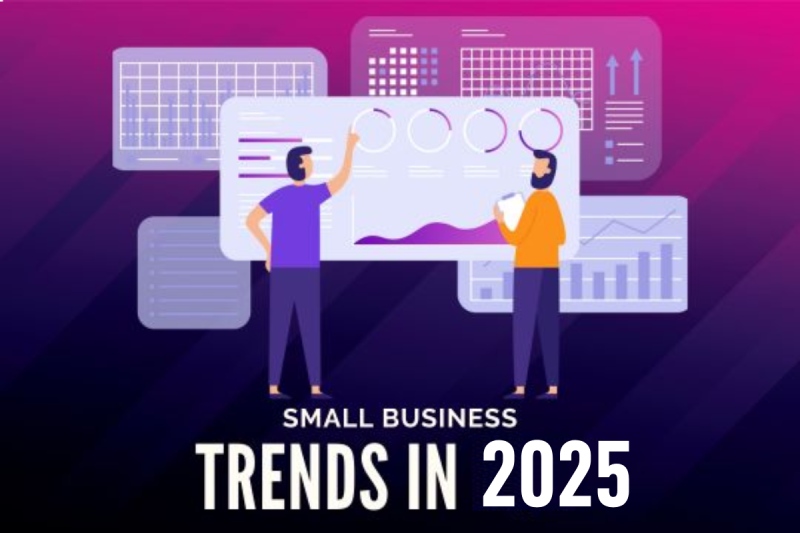
The business landscape is currently defined by rapid innovation, demanding continuous adaptation to digital improvements, and is predicted to grow by 2025. To remain competitive in the online world, it is vital to understand and capitalize on current trends. While some are fads, several small business trends might help you build your brand and gain a competitive advantage. But first, you need to know what to jump on and what to ignore.
What are these trends, and how can you incorporate them into your business to prepare for growth in the upcoming year? This article presents seven small business trends for 2025 that can help you achieve long-term success. Continue reading!
With preventive pandemic measures lifted long ago, remote work has evolved into a viable business practice that remains popular today. Remote and hybrid modes have opened up new opportunities for employees, increasing their flexibility and overall satisfaction. These primarily focus on preventing employees from rushing to the office on a regular basis and making them feel at ease at work.
These work formats are advantageous because they are affordable, which is always advantageous for small businesses. Here are a few factors to consider before using these modes in your business:
For small businesses, social media platforms have emerged as one of the most efficient marketing trends. With the ability to define different target parameters such as location, demographics, duration, and more, social media marketing is the ideal technique for efficiently reaching your audience and increasing your visibility.
Keep the following aspects in mind to help you maximize your ROI:
User-generated content (UGC) is another marketing trend that small businesses should embrace. Large corporations can easily afford to plan lengthy and expensive marketing campaigns, while small businesses cannot. However, companies can leverage their clients’ ideas in exchange for a specific incentive. UGC is one of the most effective marketing strategies for small businesses, increasing brand loyalty by integrating customers into content creation.
UGS is a cost-effective solution to increase social proof and freshen up your content calendar. To make it work, establish rules, requirements, and incentives for those whose content you approve. By doing this, you will be able to determine the formats that you accept and the stimuli that people can receive from delivering noteworthy content.
When it comes to business intelligence trends, brands are increasingly turning to multi-cloud infrastructure. Security and disaster recovery are improved as a result of this strategy’s reduction in vendor dependence. While it may appear expensive, working with a few providers optimizes costs, ensures operational stability, and reduces potential risks. 83% of Oracle survey respondents confirmed using or planning to use a multi-cloud framework in their businesses.
To ease the transition, consider these tips:
Mobile business intelligence is a business trend that allows users to access data while on the go. Mobile BI, with its ease of setup and use, has huge potential to increase transparency for owners and authorized employees. One of its key features is real-time reporting, which allows for faster and more precise decision-making.
As the owner, you can simply organize critical data into complete blocks to make better business decisions, such as marketing or restocking. It also eliminates the requirement for complicated software such as SQL. Mobile BI is a fantastic way to address the frequently cited data literacy gap among company leaders.
Follow these tips to maximize the benefits of mobile business intelligence:
Despite its drawbacks and limitations, generative AI (GenAI) is a rapidly emerging technology trend in small business and major corporation development. Aside from assisting you in creating content based on your data and input, GenAI can scrape proprietary data and predict what’s coming up so you’re prepared for the next round. According to the most recent McKinsey report, over 70% of GenAI deployment will result in increased value for this business trend.
It is best to begin with GenAI gradually to ensure steady progress. Make sure to:
Automation creates opportunities for smaller brands without increasing overheads. With more companies providing no-code solutions for various tasks, automation can improve several parts of your company while saving money. These include monitoring, system administration, task reviews and approvals, database management, and others.
Furthermore, this technology trend assists small businesses in reducing human error by establishing systems without a strong technical experience and driving consistent activities. Ideally, you should:
The top seven small business trends for 2025 are focused on employee mobility and satisfaction, effective marketing, 24-hour data access, accurate predictions, and automation. As a small business, you do not need to go above and beyond when it comes to testing software and apps before deployment. Determine which trends correspond with your aims and progressively integrate them into your company.
Couples' financial planning helps them to realize their shared objectives and cohesive tactics, therefore turning… Read More
A Young Entrepreneur’s Visionary Talks with a Global Economic Leader Signal a Bold Future In… Read More
Saving money is a goal shared by all business owners. Some costs can be cut… Read More
Switching to solar energy is a smart financial move for most homeowners, but understanding the… Read More
Access to pharmacy services has evolved significantly, driven by technological advancements and changing patient needs.… Read More
The Sim Corder/Harrison Mill represents an enduring symbol of American ingenuity, community, and progress. As… Read More